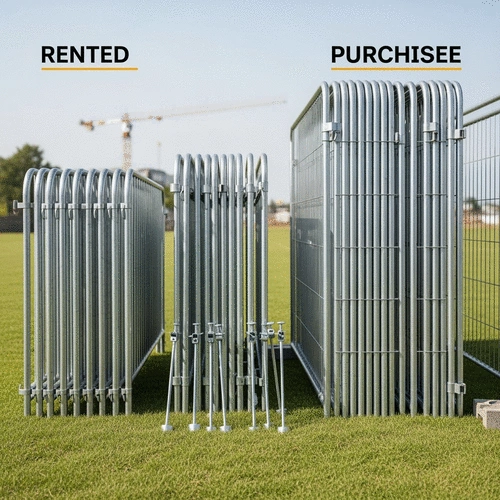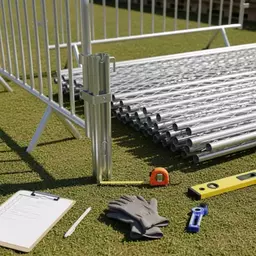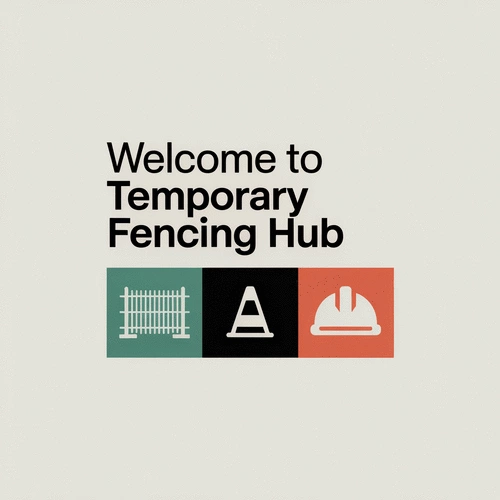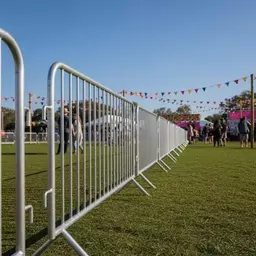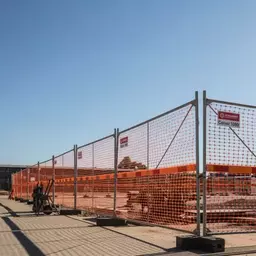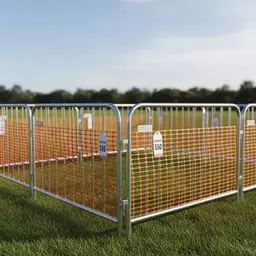As you consider temporary fencing solutions, weigh your options carefully. A wise choice could save you time, money, and hassle. What if the right information could make all the difference in your project's success?
What You Will Learn
- Temporary fencing is versatile and can be used for various applications such as construction sites, outdoor events, and public gatherings.
- Cost-effectiveness plays a crucial role; renting may have lower initial costs, but purchasing can be more economical for long-term projects.
- Material choice affects durability and safety; options include chain-link, mesh, and barrier fencing, each serving different needs.
- Sustainability matters; renting often reduces waste and emissions, while high-quality purchased fencing can also minimize environmental impact over time.
- Understanding local regulations can help ensure compliance and prevent potential legal issues related to temporary fencing use.
- Assessing your project goals and needs will guide whether renting or purchasing fencing is the best choice for your situation.
Renting vs. Purchasing Temporary Fencing: A Comparative Overview
This visual compares the key factors influencing the decision to rent or purchase temporary fencing solutions, considering project duration, budget, and environmental impact.
Renting Temporary Fencing
- ✓ Lower upfront costs
- ✓ Ideal for short-term projects
- ✓ Reduced waste (reused materials)
- ✓ No maintenance/storage costs
Purchasing Temporary Fencing
- ✓ Higher initial costs
- ✓ Cost-effective for long-term use
- ✓ Potential for higher waste if not reused
- ✓ Requires maintenance & storage
Decision Factors Flow
Understanding Temporary Fencing Options: Rental vs. Purchase
When it comes to selecting temporary fencing solutions for your project, understanding whether to rent or purchase can greatly influence both effectiveness and budget. At Temporary Fencing Hub, I often guide clients through this decision-making process, helping them identify the best approach based on their specific needs. Let's delve deeper into the key concepts and uses of temporary fencing, and how cost-effectiveness can play a significant role in your choice.
Defining Temporary Fencing: Key Concepts and Uses
Temporary fencing serves a variety of purposes, from securing construction sites to managing crowd control at events. Its versatility is one of its strongest advantages. Here are some common applications:
- Construction sites: Prevent unauthorized access and ensure safety.
- Outdoor events: Control crowds and guide attendees effectively.
- Sports facilities: Mark areas for spectators and participants.
- Public gatherings: Provide security and manage flow.
Understanding these uses can help you choose the right fencing type to meet your project's requirements. Whether you're organizing a festival or managing a construction site, knowing the best fit is crucial.
Why Cost-Effectiveness Matters for Your Project
Cost-effectiveness is often a deciding factor between renting and purchasing temporary fencing. As someone with a decade of experience in the temporary fencing industry, I can tell you that the right financial choice can save you a lot of hassle. Consider these points:
- Initial costs: Renting may have lower upfront costs compared to purchasing.
- Long-term use: If your project extends over many months, buying could be more economical.
- Maintenance: Think about ongoing costs related to upkeep, which can differ significantly between the two options.
By evaluating these factors, you can determine which option aligns best with your project's financial strategy. A well-thought-out decision can lead to substantial savings!
Exploring Different Types of Temporary Fencing: Material Quality and Durability
The type of material you choose for your temporary fencing can impact both durability and cost. At Temporary Fencing Hub, we categorize fencing into several types based on material:
- Chain-link fencing: Durable and visible, great for construction sites and crowd control.
- Mesh fencing: Lightweight and ideal for events where visibility is key.
- Barrier fencing: Sturdy and secure, perfect for high-traffic areas.
Each material has its strengths and weaknesses, making it essential to assess your project needs before making a decision. Choosing the right material can enhance safety and ensure that your temporary fencing serves its purpose effectively. For more details, consider our guide on Australian Temporary Fencing Safety Standards.
To embed a suitable YouTube video on the topic "Temporary Fencing Rental vs. Purchase: Which Option is More Cost-Effective for Your Project?" in your blog post, you should use a video that directly addresses the cost-effectiveness comparison between renting and buying temporary fencing. Based on available information (as I cannot directly search YouTube in real time), a likely candidate is "Should You Rent or Buy Fence? – Pros & Cons Explained" by United Rent-A-Fence, which is a reputable source in the industry. However, I cannot confirm the video’s current availability, viewability, embeddability, or language directly at this moment. Therefore, I will provide you with a *template* embed code using a placeholder {video_id}. **You must replace {video_id} with the actual YouTube video ID of your chosen, verified video** that meets all the criteria above, and replace {video_title} with its exact title as it appears on YouTube.**To use this code:** 1. **Find the video**: Search YouTube for a title such as "Rent vs Buy Temporary Fence – Which is Cheaper?" or similar. Ensure the video is currently live, viewable, embeddable, and in English. 2. **Get the video ID**: Copy the string of characters after `v=` in the video’s URL (e.g., for `youtube.com/watch?v=abcd1234`, the ID is `abcd1234`). 3. **Get the video title**: Copy the exact title as it appears on YouTube. 4. **Replace placeholders**: In the code above, replace `{video_id}` and `{video_title}` with the actual values. **If you provide a specific YouTube video URL, I can generate the exact embed code for you.** If you need a real-time YouTube search, I recommend using YouTube’s search feature directly, then verifying the embed status by right-clicking the video and selecting “Copy embed code.” If the option is available, the video is embeddable. Copy the video ID and title into the template above for a responsive, accessible embed.
Pro Tip
Did you know? When selecting temporary fencing, consider the specific needs of your project and the environment in which the fencing will be used. For instance, if you anticipate high winds or heavy foot traffic, opting for sturdy chain-link fencing over lighter mesh can provide better security and durability. Always assess your location and requirements before making a decision!
Environmental Considerations: Sustainability in Temporary Fencing Choices
When it comes to temporary fencing, sustainability is an important factor that cannot be overlooked. As we strive to make more eco-friendly choices in our projects, understanding the environmental impacts of renting versus purchasing fencing becomes crucial. Both options have their own benefits and drawbacks, and weighing them can help you make a decision that aligns with your values and project goals.
Renting vs. Purchasing: Environmental Impacts and Benefits
First, let’s break down the environmental aspects of both renting and purchasing temporary fencing. Renting often involves using materials that are designed for multiple uses, which can significantly reduce waste. Moreover, rental companies typically have systems in place to maintain and recycle their fencing, contributing to less landfill overflow.
- Reduced Waste: Rental fencing is reused for various projects, minimizing the need for new materials.
- Lower Carbon Footprint: Rentals often come from local sources, decreasing transportation emissions.
- Material Quality: High-quality rental fences are built to last and withstand multiple uses without wear.
On the other hand, purchasing fencing can lead to higher waste levels if the materials are not reused or adequately recycled. However, if you choose high-quality, durable fencing, it can serve you well over a long period, thus minimizing your overall environmental impact over time.
Local Regulations and Their Role in Temporary Fencing Selection
Before diving into your project, it’s essential to consider local regulations that may influence your fencing choice. Different regions may have specific guidelines regarding material use, waste disposal, and even the type of fencing permitted for various applications. Understanding these requirements can save you from potential headaches down the line.
- Compliance: Ensure your choice complies with local laws to avoid fines.
- Safety Standards: Familiarize yourself with any safety standards that apply to temporary fencing in your area.
- Eco-Friendly Options: Look for fencing that meets sustainability standards set by local councils.
By keeping local regulations in mind, you can make an informed decision that not only meets your project needs but also contributes positively to the community and environment.
Making the Right Choice for Your Specific Needs
Now that we've explored the environmental considerations of temporary fencing, let’s turn our attention to how to make the best choice for your specific needs. As the founder of Temporary Fencing Hub, I’ve seen firsthand how critical it is to align your project goals and budget when deciding between renting and purchasing fencing.
Assessing Your Project Goals and Budget
Your project goals and budget should lead your decision-making process. Are you hosting a one-time event or managing a long-term construction site? This distinction can heavily influence whether renting or purchasing fencing is more financially viable. I recommend taking a moment to ask yourself:
- How long will my project last?
- What specific safety and crowd control measures do I need?
- Am I prepared for ongoing maintenance and storage if I purchase fencing?
By reflecting on these questions, you can better gauge what option will serve you best in the long run.
Key Takeaways: Rental or Purchase—What Fits Best?
In the grand scheme of your project, the choice between rental and purchase will ultimately depend on a few key factors:
- Duration: Short-term projects often favor rentals, while long-term projects can benefit from purchases.
- Budget: Rentals may have lower upfront costs, but purchases can be cost-effective over time.
- Environmental Impact: Consider the sustainability of your choice based on local practices.
Each option has its strengths, so weigh them against your unique project needs. Don’t hesitate to reach out for advice tailored specifically to your situation!
Evaluating Event Security and Crowd Control Needs in Your Decision
When it comes to events, security and crowd control are paramount. As you assess your fencing options, keep in mind the specific requirements of your event. Different settings may demand varying types of fencing to ensure safety and effective crowd management.
- High-traffic Events: Consider sturdy, visible barriers like chain-link fences.
- Low-key Gatherings: Aesthetic options such as mesh fencing can be ideal.
- Security Needs: Ensure the fencing you choose can adequately secure your area against unwanted entry.
This thoughtful evaluation will not only enhance safety but also enhance the overall experience for your attendees. After all, ensuring a secure environment is key to a successful event! Learn more about guidelines for event fencing setup.
Your Next Steps: Engaging with Temporary Fencing Providers
As you navigate your options, the next crucial step is engaging with temporary fencing providers. I encourage you to reach out, ask questions, and collect quotes to find the best fit for your project!
How to Get Quotes and Compare Options
Getting quotes from multiple providers can give you a clearer picture of pricing and options available. Make sure to:
- Request detailed quotes that outline all potential fees.
- Compare rental and purchase offers side-by-side to assess value.
- Look for any included services, such as delivery and setup.
This comparison will empower you to make an informed decision.
Questions to Ask Providers About Rental and Purchase Offers
When speaking with potential providers, don’t hesitate to ask thorough questions. Here are some to consider:
- What are the specific rental terms, including duration and logistics?
- Are there any hidden fees associated with purchases?
- How do you handle maintenance and support for purchased fencing?
These questions will help clarify your options and ensure you choose a provider that meets your needs.
Understanding Rental Agreements and Deposit Requirements
Finally, understanding the terms of rental agreements is crucial to avoid surprises later. Pay attention to:
- Deposit amounts and refund conditions.
- Cancellation policies and potential penalties.
- Any conditions for damages or late returns.
By knowing what to expect, you can engage confidently with your chosen provider and focus on the success of your project!
Recap of Key Points
Here is a quick recap of the important points discussed in the article:
- Temporary fencing is versatile and can be used for construction sites, outdoor events, sports facilities, and public gatherings.
- Cost-effectiveness is key; renting may save upfront costs, but purchasing can be more economical for long-term projects.
- Material choice impacts durability; options include chain-link, mesh, and barrier fencing, each suited to different needs.
- Sustainability matters; renting reduces waste and carbon footprint, while high-quality purchases can minimize environmental impact over time.
- Local regulations should guide your fencing choice to ensure compliance and safety.
- Evaluate your project goals and budget to determine whether renting or purchasing is the best fit for your needs.
Frequently Asked Questions (FAQs)
What are the main uses of temporary fencing?
Temporary fencing is primarily used for securing construction sites, managing crowd control at outdoor events, marking areas in sports facilities, and providing security at public gatherings.
Is it more cost-effective to rent or purchase temporary fencing?
Renting often has lower upfront costs and is ideal for short-term projects. Purchasing can be more cost-effective for long-term projects due to the absence of recurring rental fees, but requires initial investment and accounts for maintenance and storage.
What types of materials are commonly used for temporary fencing?
Common materials include chain-link fencing (durable for construction and crowd control), mesh fencing (lightweight for events where visibility is key), and barrier fencing (sturdy for high-traffic areas).
How does temporary fencing impact the environment?
Renting temporary fencing is generally more sustainable as materials are reused, reducing waste and often lowering the carbon footprint due to local sourcing. Purchasing can also be sustainable if high-quality, durable fencing is chosen and reused over a long period, minimizing overall environmental impact.
Why are local regulations important when choosing temporary fencing?
Local regulations are crucial for ensuring compliance, avoiding fines, and meeting specific safety standards. They may dictate material use, waste disposal, and the types of fencing permitted for various applications.

